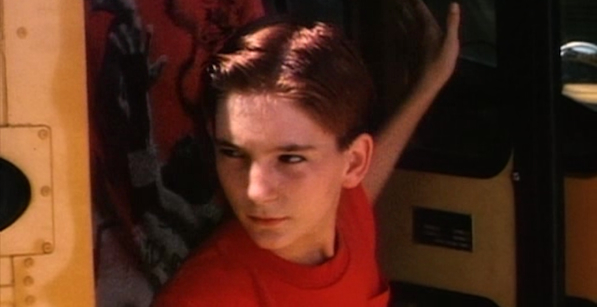Redboy 13, Marcus van Bavel’s lo-fi spy adventure epic, has yet to reach the cult status it seems made for. Shot on CinemaScope on a homemade soundstage, with CGI special effects programmed by the director, the film follows a 13-year old government-trained assassin on a final mission to eliminate the power-mad, Neo-Nazi scientist Dr. Heimlich Manure.
To get a full appreciation of the resourcefulness and go-for-it indie spirit that drove this production, you have to read this interview with van Bavel by C. Arnold Barent. The following are selected highlights from the interview; the full Q&A can be found on his website. And of course, watch the film to see van Bavel’s DIY use of CinemaScope, CGI and his backyard soundstage in action – and see if you can spot him in the five roles he plays onscreen!

Q: So what’s a REDBOY 13?
A: It’s a codename for this spy, a kid who is hired and trained by a half-crazed Air Force Colonel and inducted into a secret branch of the military called the “CYA.” The kid’s an assassin and a counter-terrorist agent, kind of a mix of James Bond and Rambo, but carries a Teddy Bear. Unfortunately for the CYA, it’s the end of the Cold War and the dirty tricks budget has been slashed. So they are forced to operate illegally, fighting bad guys and the FBI at the same time. In addition, little Redboy has his own problems– his family is breaking up, he’s not doing well in school… and he’s tired of being a killer and wants to return to normal life.

Q: For a low-budget film, it has an interesting look, kind of an epic feeling, in some scenes. How did you achieve that?
A: Choice of music, maybe, the 35mm CinemaScope format, and the 30-ft camera boom that we used for some of the scenes, especially when Redboy is running to school. I like the sweeping movements and the over-dramatic score… kind of gives it a Lawrence of Arabia feel. Also the presence of the Mt. Rushmore-esque Robert Logan, veteran of epics like “Bridge at Remagen” and other pictures. The style of photography, which is deliberately static for dialog, then mobile for action sequences… is a throwback, really, to when sound cameras were heavy, bulky. A lot of REDBOY was shot with a Mitchell camera, practically an antique I suppose, but it has a certain quality you don’t get nowadays.
Q: There’s a lot of planes, helicopters, and tanks in the movie. Some of it’s pretty impressive. How did you do it?
A: Couldn’t afford the real thing, of course– I think a C5A costs ten grand an hour to fly, just in kerosene. Those shots are a mix of miniatures and computer animation. My profession, my “day job” is software engineering, and I’ve been messing around with 3D animation since I was a kid. For REDBOY, I ported over an old animation and rendering program of mine, originally written in FORTRAN, to the SGI Indigo Elan. Back then, in 1994, film animation packages like “Alias” were going for $100K plus, and I couldn’t afford that. So I rolled my own, using the the built-in libraries of the Indigo, and put together a film recorder from a high-res monitor and the same Mitchell camera that was used for the live action.

Q: You play a few parts in REDBOY. Three parts.
A: Yeah, reduced down from 25 in the COMEDY MASSACRE. That was a world record, I think. Maybe I should apply. Actually four parts in REDBOY: the helicopter pilot, Doctor Zed, Doctor Heimlich Manure, and also the reporter that gets the camera shoved down his throat.
Q: Why do you do that, play different parts?
A: I dunno, it makes it fun for me. Just directing isn’t enough of a challenge. I’m a frustrated Peter Sellers. The characters are so different, so buried in makeup and accents I don’t think anyone will guess that they’re the same person.
Q: How did you finance the film? What was the budget?
A: I raised a small amount to start the film, all from private investors. Mostly people who knew me pretty well, probably felt sorry for me… never underestimate the sympathy factor. But that was only enough to shoot the dialog scenes. To finish the film, I had to spend many, many times the original investment. The completion money came from a variety of sources. One guy, Ed Toutant, put up his winnings from “Jeopardy.” I put in money I got from ABC… so in a small way, REDBOY was financed from trash TV! As to the total dollar amount– I’m holding my cards closely, I guess. I know that many people are intensely curious about that sort of thing… maybe I can be more open about it after the film is sold. It was a “medium” budget film… somewhere between EL MARIACHI and WATERWORLD.
Q: Anxious to quit your day job and become a professional film maker?
A: Oh, I dunno. If the right thing came along. I kind of like my amateur status. There seems to be a resurgent interest in science fiction, though, and I have the equipment, the know-how, and the inclination to make a science fiction film, I mean a really good one, sci-fi that’s fun to watch but doesn’t insult your intelligence… I wish I could get several million to do that. But if not, I’ll probably make it anyway, just with the money I make from REDBOY. I’ve also written a couple of action-comedies which could be made very cheaply. We’ll see.




